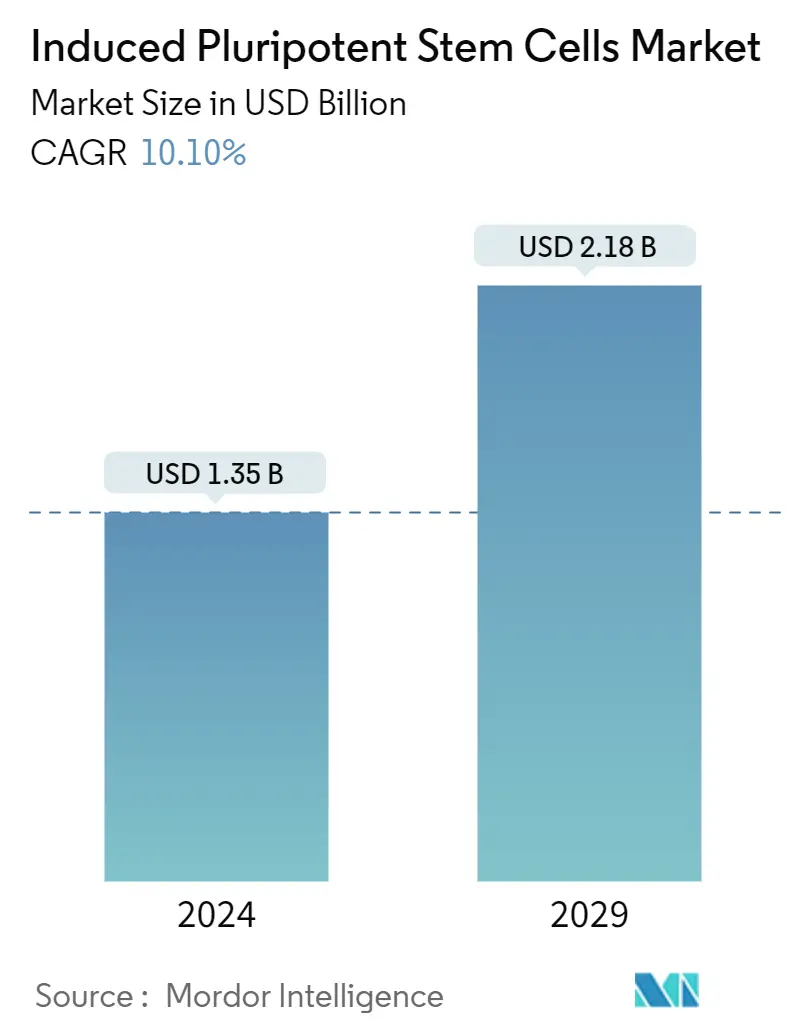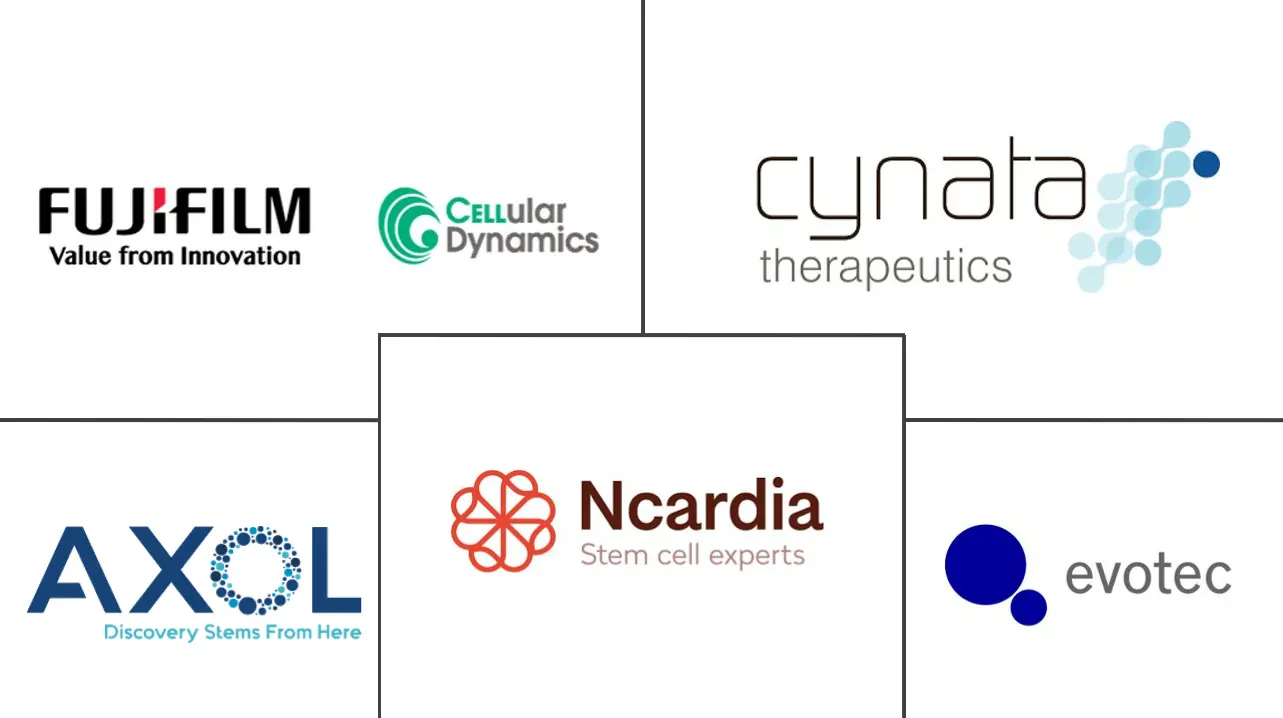Market Size of Induced Pluripotent Stem Cells Industry

| Study Period | 2019 - 2029 |
| Market Size (2024) | USD 1.35 Billion |
| Market Size (2029) | USD 2.18 Billion |
| CAGR (2024 - 2029) | 10.10 % |
| Fastest Growing Market | Asia-Pacific |
| Largest Market | North America |
Major Players
*Disclaimer: Major Players sorted in no particular order |
Induced Pluripotent Stem Cells (iPSCs) Market Analysis
The Induced Pluripotent Stem Cells Market size is estimated at USD 1.35 billion in 2024, and is expected to reach USD 2.18 billion by 2029, growing at a CAGR of 10.10% during the forecast period (2024-2029).
The COVID-19 pandemic has imposed a great burden on the healthcare sector as most chronic therapies were postponed and all outpatient treatments were delayed or restricted during the COVID-19 pandemic to lower the risk of viral transmission. Several studies on cell therapies have demonstrated their potential to modulate the immune response by controlling cell function and downregulating inflammatory cytokines, which aids in lowering COVID-19 patients' mortality and morbidity rates. For instance, according to an article published in Molecular Biomedical, in February 2022, stem cells have demonstrated promising results in clinical studies for treating COVID-19 disease by altering the immune system. In addition, as per an article published in Frontiers in Cell and Development Biology, in September 2021, it has been observed that human induced pluripotent stem cell (iPSC)-derived cellular and organoid models provide useful platforms for in vitro simulation of viral life cycles and drug screening to prevent coronavirus reemergence. Also, these iPSC-derived models can recapitulate the functions and physiology of various human cell types and assemble complex microenvironments, hence increasing the study efficiency of viral infection mechanisms, and mimicking the actual host-virus interaction. Thus, with the increased use of stem cells, the market has witnessed significant growth during the pandemic.
Factors such as the increase in R&D activities in stem cell therapies and the surge in the adoption of personalized medicines are expected to boost market growth over the forecast period.
The rise in the prevalence of personalized medicines for various disease treatments is expected to increase the company's focus to accelerate the adoption of induced pluripotent stem cells in developing therapies. For instance, as per an article published in the Journal of Personalized Medicine, in August 2022, it has been observed that iPSCs generated from individuals with a variety of monogenic and polygenic disorders, provide a valuable resource for developing individualized models of psychiatric diseases that help researchers to better understand the underlying molecular and cellular pathways. The same source also stated that the researchers discovered biomarkers, including synaptic connectivity and morphology changes as well as specific gene expression, for the bupropion response in lymphoblastoid cell lines (LCLs) from major depressive disorder (MDD) that had been reprogrammed to iPSC and differentiated into cortical neurons. Thus, the utilization of LCLs in obtaining several biomarkers is expected to promote personalized treatment options for patients suffering from MDD, thereby bolstering market growth.
Moreover, the growing company's focus on adopting various business strategies such as agreements, collaborations, and other initiatives is expected to increase the utilization and production of iPSCs in clinical research, thereby contributing to market growth. For instance, in January 2022, Century Therapeutics signed a research collaboration and license agreement with Bristol Myers Squibb to develop and commercialize up to four induced pluripotent stem cell-derived, engineered natural killer cell ('iNK') and/or T cell ('iT') programs for hematologic malignancies and solid tumors. Also, in November 2021, Ncardia, a human-induced pluripotent stem cell company, signed a USD 60 million funding deal with Kiniciti to expand discovery and commercial production services for stem cells.
Therefore, owing to the aforementioned factors, such as increasing company focus on utilizing induced pluripotent stem cells in the R&D of drugs and other therapies as well as growing demand for personalized medicines, the studied market is anticipated to grow over the forecast period. However, the lack of awareness regarding stem cell therapies and the high cost of treatment is likely to hinder the growth of the induced pluripotent stem cells market over the forecast period.
Induced Pluripotent Stem Cells (iPSCs) Industry Segmentation
As per the scope of the report, induced pluripotent stem cells are a type of stem cell that could be generated from a somatic cell. Induced pluripotent stem cells (iPSCS) are created by causing terminally differentiated somatic cells to revert to pluripotency by chemical or genetic reprogramming. The Induced Pluripotent Stem Cells Market is Segmented by Derived Cell Type (Hepatocytes, Fibroblasts, Keratinocytes, Neurons, and Others), Application (Drug Development, Regenerative Medicine, Toxicity Testing, Tissue Engineering, and Cell Therapy, and Disease Modelling), End User (Research Institutions and Other End Users) and Geography (North America, Europe, Asia-Pacific, Middle East and Africa and South America). The Market report also covers the estimated market sizes and trends of 17 countries across major regions globally. The report offers values (in USD million) for the above segments.
| By Derived Cell Type | |
| Hepatocytes | |
| Fibroblasts | |
| Keratinocytes | |
| Neurons | |
| Others |
| By Application | |
| Drug Development | |
| Regenerative Medicine | |
| Toxicity Testing | |
| Tissue Engineering | |
| Cell Therapy | |
| Disease Modeling |
| By End User | |
| Research Institutions | |
| Other End Users |
| Geography | ||||||||
| ||||||||
| ||||||||
| ||||||||
| ||||||||
|
Induced Pluripotent Stem Cells Market Size Summary
The induced pluripotent stem cells (iPSC) market is poised for significant growth, driven by advancements in regenerative medicine and the increasing adoption of personalized medicine. iPSCs, which are reprogrammed from somatic cells, offer unique advantages such as self-renewal and the ability to differentiate into various cell lineages, making them a valuable tool in regenerative therapies. The market is experiencing a surge in research and development activities, with companies focusing on utilizing iPSCs for drug development and therapeutic applications. The COVID-19 pandemic has further accelerated the use of iPSCs, as they have shown potential in modulating immune responses and serving as models for viral studies. This has led to increased interest and investment in iPSC technologies, contributing to the market's expansion.
The market is characterized by a competitive landscape with key players engaging in strategic collaborations, mergers, and product launches to strengthen their market position. North America is expected to hold a significant share due to its advanced technological adoption and substantial research funding. Government initiatives and funding are also playing a crucial role in promoting iPSC research and development, enhancing the market's growth prospects. Despite the promising growth trajectory, challenges such as high treatment costs and limited awareness about stem cell therapies may hinder market expansion. Nonetheless, the ongoing advancements and increasing focus on personalized medicine are anticipated to drive the market forward over the forecast period.
Induced Pluripotent Stem Cells Market Size - Table of Contents
-
1. MARKET DYNAMICS
-
1.1 Market Overview
-
1.2 Market Drivers
-
1.2.1 Increase in Research and Development Activities in Stem Cells Therapies
-
1.2.2 Surge in Adoption of Personalized Medicine
-
-
1.3 Market Restraints
-
1.3.1 Lack of Awareness Regarding Stem Cell Therapies and High Cost of Treatment
-
-
1.4 Porter's Five Forces Analysis
-
1.4.1 Threat of New Entrants
-
1.4.2 Bargaining Power of Buyers/Consumers
-
1.4.3 Bargaining Power of Suppliers
-
1.4.4 Threat of Substitute Products
-
1.4.5 Intensity of Competitive Rivalry
-
-
-
2. MARKET SEGMENTATION
-
2.1 By Derived Cell Type
-
2.1.1 Hepatocytes
-
2.1.2 Fibroblasts
-
2.1.3 Keratinocytes
-
2.1.4 Neurons
-
2.1.5 Others
-
-
2.2 By Application
-
2.2.1 Drug Development
-
2.2.2 Regenerative Medicine
-
2.2.3 Toxicity Testing
-
2.2.4 Tissue Engineering
-
2.2.5 Cell Therapy
-
2.2.6 Disease Modeling
-
-
2.3 By End User
-
2.3.1 Research Institutions
-
2.3.2 Other End Users
-
-
2.4 Geography
-
2.4.1 North America
-
2.4.1.1 United States
-
2.4.1.2 Canada
-
2.4.1.3 Mexico
-
-
2.4.2 Europe
-
2.4.2.1 Germany
-
2.4.2.2 United Kingdom
-
2.4.2.3 France
-
2.4.2.4 Italy
-
2.4.2.5 Spain
-
2.4.2.6 Rest of Europe
-
-
2.4.3 Asia-Pacific
-
2.4.3.1 China
-
2.4.3.2 Japan
-
2.4.3.3 India
-
2.4.3.4 Australia
-
2.4.3.5 South Korea
-
2.4.3.6 Rest of Asia-Pacific
-
-
2.4.4 Middle East and Africa
-
2.4.4.1 GCC
-
2.4.4.2 South Africa
-
2.4.4.3 Rest of Middle East and Africa
-
-
2.4.5 South America
-
2.4.5.1 Brazil
-
2.4.5.2 Argentina
-
2.4.5.3 Rest of South America
-
-
-
Induced Pluripotent Stem Cells Market Size FAQs
How big is the Induced Pluripotent Stem Cells Market?
The Induced Pluripotent Stem Cells Market size is expected to reach USD 1.35 billion in 2024 and grow at a CAGR of 10.10% to reach USD 2.18 billion by 2029.
What is the current Induced Pluripotent Stem Cells Market size?
In 2024, the Induced Pluripotent Stem Cells Market size is expected to reach USD 1.35 billion.

